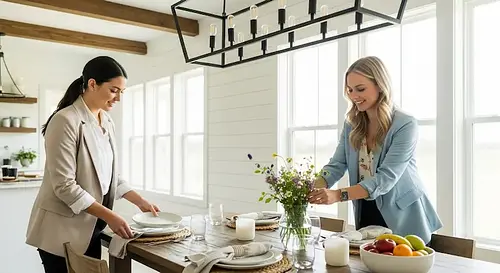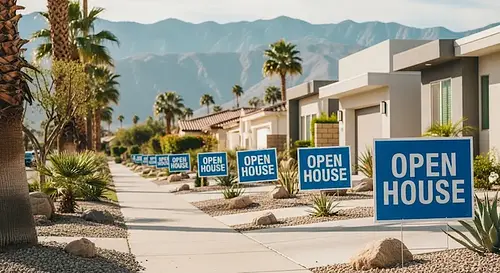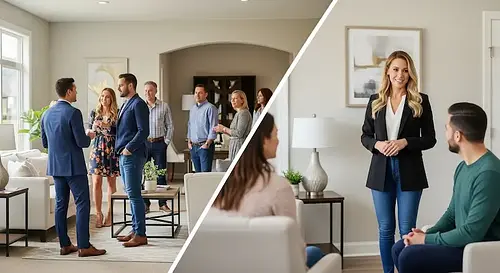The Complete Open House Strategy For Real Estate Teams
Looking to build a reliable open house strategy for real estate teams? This step-by-step guide shows team leaders how to systemize scheduling, lead capture, follow-up, and reporting—so open houses become a repeatable engine for growth, not just a weekend task.

Written by Seth Cox
Jun 20, 2025 / Open house marketing
The truth is, most real estate teams treat open houses as isolated events instead of what they really are: one of the most powerful, repeatable lead generation opportunities in the business. But without a clear strategy, a centralized process, and the right tools in place, even high-traffic open houses often fail to turn visitors into clients.
This guide is built for team leaders who want to change that. Whether you’re running a team of two or twenty, you’ll learn how to systemize your open house approach from top to bottom—scheduling, sign-ins, follow-up, reporting, and everything in between. We’ll walk through the exact goals to set, the tools to use, and the metrics to track so your team can start treating open houses not as a chore, but as a scalable growth engine.
Let’s build your complete open house strategy—one that drives leads, listings, and closings at scale.

1. Open House Goal Setting for Team Leaders
Measurable Open House Goals
- Activity Goals – How many open houses should each agent be hosting per month?
- Lead Generation Goals – How many qualified leads should be captured at each event?
- Conversion Goals – How many of those leads should convert to appointments and clients?
- Outcome Goals – How many closed deals or listings should come from open house activity?
Each of these works together to form a complete, trackable funnel. Let’s break them down.
Activity Goals: Set the Standard for Consistency
- 4 open houses per month per agent
- More for newer agents looking to build a pipeline quickly
- Fewer, but more strategic, for top producers focused on listings
Lead Generation Goals: Make Every Visitor Count
- 15 to 25 sign-ins per open house
- Sign-in rate greater than 70% of total attendees
Conversion Goals: Appointments and Pipeline Growth
- 20% to 30% of sign-ins into appointments
- That’s 3 to 5 appointments per open house with average lead volume
Outcome Goals: Clients and Closings That Count
- 10% to 20% of appointments become active clients
- 50%+ of those clients will close if nurtured properly

2. Open House Scheduling Process
Why Listing Managers Should Handle Scheduling
- Less confusion over who’s hosting what
- Stronger quality control on signage, staging, and preparation
- Better coverage across your listing portfolio
- More accountability in follow-up and reporting
When scheduling is owned by one person, it stops being chaotic and starts becoming strategic.
What a Scalable Scheduling System Should Include
- Add new open houses quickly
- Assign agents, guest hosts, or team members
- Avoid double-booking and calendar conflicts
- Notify everyone involved with clear next steps
The best systems also generate sign-in forms automatically and keep a history of who hosted which event—so you’re never left guessing when reviewing team performance.
Build Around Team Roles and Permissions
For example, a listing manager might create and assign open houses, while agents are notified and prepped to host. Guest hosts can be looped in with limited access, without requiring full permissions or messy workarounds.
Create Visibility Across the Team
- Fill scheduling gaps
- Ensure newer agents get enough reps
- Balance the workload fairly
- Track participation across your team

3. Open House Hosting Process
Promote the Open House to Boost Attendance
- MLS and listing syndication – Make sure the open house is published and visible on major platforms like Zillow and Realtor.com.
- Email outreach – Send announcements to your buyer database and local sphere.
- Social media posts – Promote on Instagram, Facebook, and Stories using branded visuals and CTAs.
- Local Facebook groups – Post the event to real estate or neighborhood-specific groups.
- Abundant Open House Signage – Ensure signs are placed early, visible, and approved by the city or HOA.
Teams that use ready-made templates and repeatable messaging systems tend to promote more consistently. If you need a shortcut, we’ve compiled free Canva templates for open house social media posts to help agents get started.
Build a Consistent Pre-Event Routine
- Verifying signage placement and directions
- Arriving early to stage, clean, and prepare the property
- Logging into the sign-in app or system
- Reviewing the property’s features and highlights
- Preparing talking points and follow-up materials
When every agent starts from the same foundation, the guest experience becomes more professional—and more productive.
Standardize the Guest Experience
- Greet guests at the door and guide the flow of the visit
- Offer a brief intro to the property and invite questions
- Collect contact details before the tour begins
- Ask light qualifying questions in a conversational way
- Offer next steps (appointment, CMA, market insights) before they leave
Reinforce this process in team meetings and provide scripts or prompts as needed. The more repeatable your in-person flow is, the easier it becomes to scale results across the team.

Collect Every Visitor’s Contact Information
- Require name, email, phone, and buying timeline
- Customize the form with listing-specific details
- Tag leads as buyers, neighbors, or agents for smarter follow-up
Make it a non-negotiable: no guest should tour the home without signing in first.
Create an End-of-Event Wrap-Up Routine
- Review and annotate their leads
- Clean up signage and materials
- Submit quick notes on how the event went (foot traffic, objections, wins)
This short debrief ensures no data is lost and helps the team improve over time. If you’re using a tool with built-in reporting, that feedback can roll into your team dashboards automatically.

4. Open House Feedback Collection
Make Agent Feedback a Non-Negotiable
- Estimated foot traffic
- Number of quality leads (e.g. serious buyers vs. neighbors)
- Any standout conversations, objections, or buyer feedback
- Whether the setup process and sign-in system went smoothly
- Notes on staging, signage, or anything that needs improvement
Automate Host Feedback Collection
As a team leader, this gives you real-time visibility into:
- Which open houses are generating the best results
- Where individual agents may need more training
- How specific listings are being received by the public
Use Feedback to Drive Better Performance
Over time, you can identify:
- Which listings attract the most traffic and serious buyers
- Which agents are consistently high-converting (or struggling)
- What setup or marketing adjustments lead to better outcomes

5. Open House Follow-Up Plan
The challenge isn’t that agents don’t want to follow up. It’s that the process—from collecting leads to entering them into a CRM—often breaks down the moment the event ends.
The Connection Between Open Houses and CRMs
This is the real breakdown: the agent hosts a great open house, collects contact info, then has to manually type every name, email, and phone number into the CRM… if they remember to do it at all.
The result? Leads fall through the cracks. Agents forget who they spoke with. And the open house becomes a dead end instead of a conversion opportunity.
Automate Lead Capture and Sync to Your CRM
- Full name
- Email address
- Phone number
- Lead type (buyer, seller, renter, agent)
- Whether they already have an agent
Tip: Showable captures all of this data and syncs it directly to your CRM—most commonly Follow Up Boss—without any manual entry. That alone can be the difference between scattered follow-up and real pipeline growth.
Trigger Automated Follow-Up the Moment They Sign In
- Buyers receive a follow-up email with similar listings
- Sellers are offered a home valuation report
- Renters go into a drip campaign for future buyer conversion
- Visitors with an agent get a polite “thank you for attending” and are removed from further follow-up
This automation should happen immediately, while the open house is still fresh in the visitor’s mind. With Showable’s CRM integration, this can happen the moment the lead signs in—no extra steps required.
Still Follow Up Like a Human
- Every buyer lead gets a personal text or call within 24 hours
- Every seller gets a follow-up CMA or local market update
- Notes from the open house (stored in your CRM) are reviewed before outreach
Hold your team accountable in weekly meetings by reviewing lead activity, contact timelines, and appointment conversion rates.
When CRM syncing, automation, and agent outreach all work together, follow-up becomes a competitive advantage—not a liability.

6. Open House Reporting
Internal Reporting: Use Data to Drive Coaching and Accountability
Each open house should generate a simple, standardized record that includes:
- Who hosted the event
- Number of visitors and sign-ins
- Types of leads captured (buyer, seller, renter, agent)
- Follow-up status or notes
- Any issues or feedback logged by the host
Tip: With Showable’s reporting dashboard, this data is tracked automatically and organized by agent, listing, or date—so you can quickly spot high performers, identify gaps, and adjust your strategy in real time.
Use internal reports to:
- Coach underperforming agents on follow-up or conversion
- Identify listings that consistently underdeliver
- Make smarter decisions about where to allocate open house coverage
- Celebrate small wins—like new clients gained directly from weekend traffic
Seller Reporting: Show the Value of Your Efforts
A professional seller report builds trust and sets you apart. It should include:
- Total number of guests who attended
- Number of leads captured
- Types of attendees (e.g. buyers vs. neighbors)
- Host feedback on buyer reactions or pricing
- Planned follow-up actions and next steps
This type of reporting reassures your sellers that you’re not just “doing” open houses—you’re working a real strategy. It also opens the door to important conversations about staging, pricing, or re-listing if needed.
When Reporting is Standard, Open Houses Become Strategic

7. Bringing It All Together On One Platform
One Platform for Every Step of the Process
✔️ Schedule smarter – Listing managers can assign open houses, invite hosts, and keep everyone aligned through a shared dashboard.
✔️ Capture every visitor – Use a digital sign-in form that collects full contact info and lead type—no more paper, no more missed leads.
✔️ Sync leads to your CRM – Instantly route new contacts into your CRM (like Follow Up Boss), so agents can follow up faster with less effort.
✔️ Collect host feedback – Get post-event notes automatically from your agents, so you always know what happened and how it went.
✔️ Report with confidence – Visualize lead data, agent activity, and listing performance all in one place—for both internal coaching and seller updates.
✔️ Collaborate as a team – Add admins, agents, and guest hosts with role-based access to keep your whole team moving in sync.
Built for Teams Who Take Growth Seriously
When you have the right systems in place, open houses stop feeling like random events—and start becoming a core driver of predictable growth.

Conclusion: The Open House Strategy That Scales
When your team sets the right goals, follows a consistent hosting process, captures every lead, and automates follow-up, open houses become more than a weekend activity—they become a key growth engine.
And when you layer in internal reporting for coaching, and external reporting for seller communication, you create a feedback loop that drives continual improvement across your entire team.
Try Showable Free
Try Showable free and see how real estate teams are turning open houses into a repeatable, scalable source of growth.






